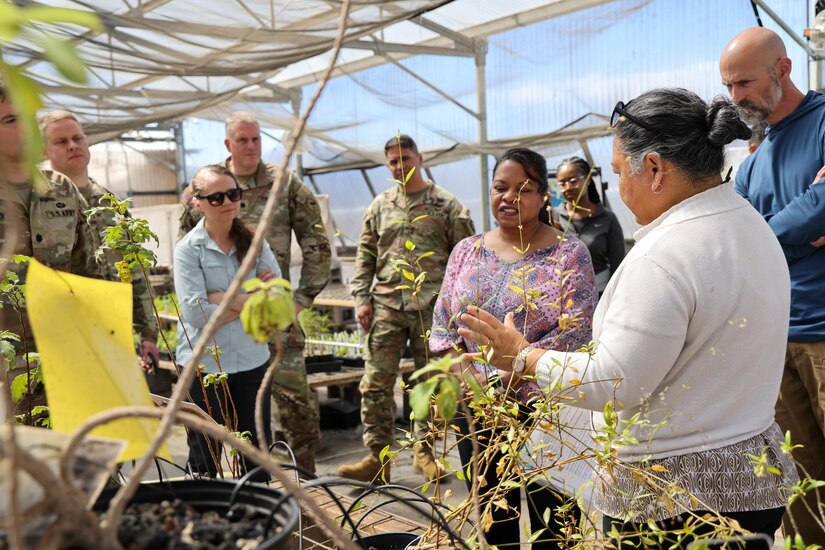Army General Counsel experiences PTA’s commitment to the land


U.S. Army’s Commitment to Sustainable Development Goals (SDGs) at Pōhakuloa Training Area
Introduction
Army General Counsel Carrie F. Ricci witnessed the U.S. Army’s dedication to the ʻāina, or land, during a tour of Pōhakuloa Training Area (PTA) led by U.S. Army Garrison Hawaii senior leaders on March 25, 2024.
About Pōhakuloa Training Area (PTA)
Pōhakuloa Training Area, also known as PTA, is the U.S. Army’s training complex located on Hawaii Island. Spanning 210 square miles, PTA consists of federally owned land as well as land leased from the state of Hawaii. Approximately 17% of PTA is leased from the state.
Conservation Efforts and Protection of Endangered Species
In addition to being a premier training area in the Pacific, PTA is home to threatened and endangered species as well as Hawaiian cultural sites that the Army is committed to safeguarding.
- The Army sustains a seed lab and greenhouse on PTA to cultivate native plants.
- The Army collaborates with Hawaii’s Department of Land and Natural Resources (DLNR) to explore opportunities for outplanting native plants within the community on the island.
Army General Counsel Carrie F. Ricci expressed her pride in the Army’s conservation efforts, stating, “There are native species of plants found nowhere else in the world but the PTA, and they continue to flourish because of the Army’s conservation efforts.”
Preservation of Cultural Sites
PTA’s cultural resources team ensures the preservation of cultural sites within the training area. Currently, there are 13 known burial sites on PTA that have been preserved in place. The Army works closely with cultural descendants to adhere to the Native American Graves Protection and Repatriation Act (NAGPRA) processes.
Army General Counsel Carrie F. Ricci emphasized the importance of protecting the land for future generations, stating, “It is critical that we protect this land for those who will depend upon it thousands of years in the future.”
Environmental Stewardship and Compliance
The Army in Hawaii invests $12 million annually in natural and cultural resource stewardship programs. While some of the Army’s conservation efforts are mandated by the land lease agreement with the state, the Army also has its own environmental requirements that must be followed, along with compliance with all federal conservation laws.
SDGs, Targets, and Indicators
| SDGs | Targets | Indicators |
|---|---|---|
| SDG 15: Life on Land | 15.5: Take urgent and significant action to reduce the degradation of natural habitats | The Army’s conservation efforts to protect threatened and endangered species and native plants at PTA |
| SDG 15: Life on Land | 15.9: By 2020, integrate ecosystem and biodiversity values into national and local planning, development processes, poverty reduction strategies, and accounts | The Army’s coordination with Hawaii’s Department of Land and Natural Resources for opportunities to outplant native plants within the community |
| SDG 11: Sustainable Cities and Communities | 11.4: Strengthen efforts to protect and safeguard the world’s cultural and natural heritage | The Army’s preservation of cultural sites on PTA, including 13 known burial sites |
| SDG 11: Sustainable Cities and Communities | 11.7: By 2030, provide universal access to safe, inclusive, and accessible, green and public spaces, in particular for women and children, older persons, and persons with disabilities | No specific indicators mentioned in the article |
1. Which SDGs are addressed or connected to the issues highlighted in the article?
The SDGs addressed or connected to the issues highlighted in the article are SDG 15: Life on Land and SDG 11: Sustainable Cities and Communities.
2. What specific targets under those SDGs can be identified based on the article’s content?
Based on the article’s content, the specific targets under SDG 15: Life on Land are 15.5: Take urgent and significant action to reduce the degradation of natural habitats, and 15.9: By 2020, integrate ecosystem and biodiversity values into national and local planning, development processes, poverty reduction strategies, and accounts. The specific target under SDG 11: Sustainable Cities and Communities is 11.4: Strengthen efforts to protect and safeguard the world’s cultural and natural heritage.
3. Are there any indicators mentioned or implied in the article that can be used to measure progress towards the identified targets?
The article mentions indicators that can be used to measure progress towards the identified targets. For SDG 15: Life on Land, the indicator is the Army’s conservation efforts to protect threatened and endangered species and native plants at PTA. For SDG 15: Life on Land, the indicator is the Army’s coordination with Hawaii’s Department of Land and Natural Resources for opportunities to outplant native plants within the community. For SDG 11: Sustainable Cities and Communities, the indicator is the Army’s preservation of cultural sites on PTA, including 13 known burial sites.
Source: pacom.mil








